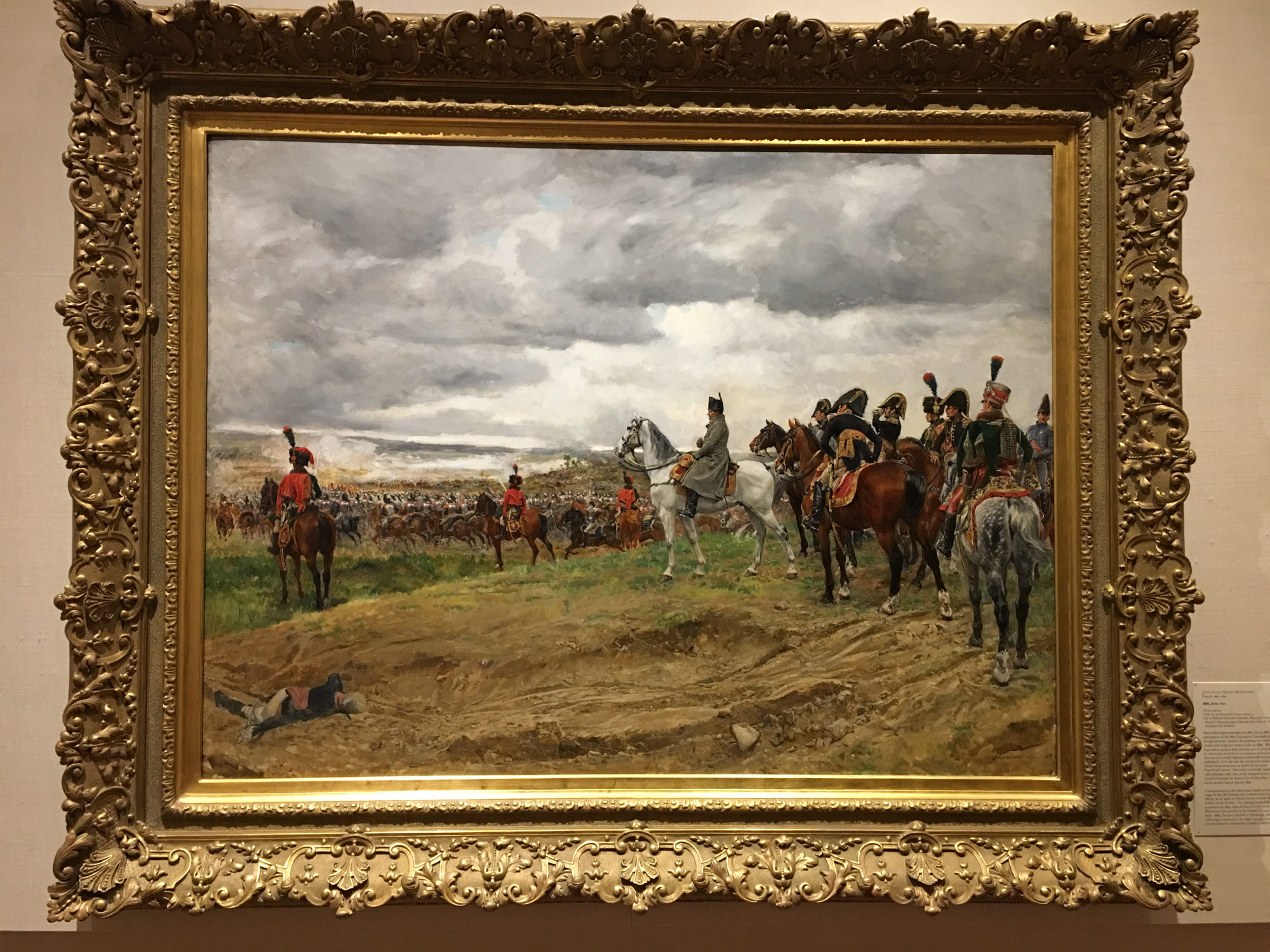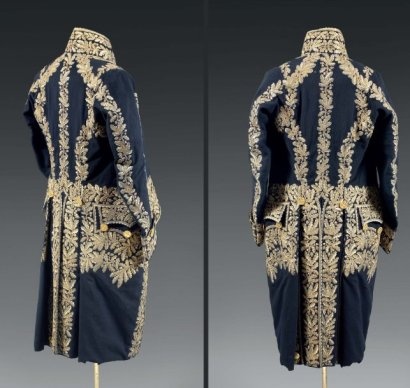When I was a kid my parents used to set me loose on the streets of Paris, with coin for admission to various museums, and a croissant and some hot chocolate. And I almost always wound up spending at least a day at Les Invalides, the military museum.
It was there that I fell in love with Napoleonic military uniforms. The idea of going to get shot to bits in such a fine outfit never made much sense, but if you’ve got to get shot to bits, you may as well be looking snappy, I suppose. My favorites were always Meissonier’s paintings, which are incredibly detailed and accurate down to every snap and rivet of the saddles, every loop of the hussar’s dolman jacket.

They said no photography but I didn’t use flash, mjr 2017
You can imagine how thrilled I was to see this old friend, which has been lovingly and expertly cleaned so that the figures practically leap out of the oil.
It’s Napoleon (of course!) at Jena,[wikipedia] watching his cavalry deploy. Behind him are some of his marshalls, with Murat and Ney conspicuously absent – they were leading different wings of the cavalry. That’s probably Lannes leaning forward on his horse. The outriders in the gold, red, and green hussars’ kit are the Chasseurs De La Garde Imperial – the imperial guard’s light cavalry. I always have a great time trying to identify the various marshalls: Ney is always portrayed with a great mane of curly red-gold locks, and Murat is usually a blaze of gold and chrome yellow velvet (really: the neapolitan hussars’ uniform was… uh.. recognizable on the battlefield)
Meissonier’s “trick” was that he had access to a huge amount of the uniforms and gear of the period and worked from live models carefully posed exactly how he wanted them.

Marshall Davout’s coat
Back in the late 80s the Metropolitan Art Museum had an exhibit of napoleonic clothes (“The Imperial Age Exhibition”) including one of Marshall Davout’s uniforms. It had something like 1/2 lb of gold sewed onto it. The way those gold trimmings are done is you drop molten gold through a shot tower, collect the shot, hammer them flat with a tiny hammer, pierce them with a needle, then tack/sew them down. At present there is one artisan who still makes the stuff, in Italy, for the papacy.
In the painting, Davout is the pissed-off looking fellow behind Napoleon, mostly blocked by Lannes. Davout was a great strategist in his own right, but operated comfortably in Napoleon’s shadow; part of what makes Meissonier’s work so great is that he studied his subjects intensely and attempted to capture likely positions and poses based on their character.
My favorite Meissonier is at the Metropolitan Art Museum; it’s of the cuirassier heavy cavalry maneuvering past the imperial lookout as they are committing into the battle at Friedland. The movement of the horses is spectacular.

You can see Murat to our right of Napoleon, in full bling, with the ever-present Chasseurs of the Imperial Guard providing security.
While I was looking around for a good picture of that painting I came across a description of it, which included the tidbit that it created some scandal because an American department store magnate purchased it sight unseen from Meissonier, for the then unheard-of price of $60,000. Some perspective: the Frick’s mansion, which I visited Sunday, cost the same amount in 1860 – they subsequently spent $300,000 turning it into one of the most expensive buildings in the US, at the time.
Money be damned; there is something that will always be priceless about hand-applied pigment, when the artist’s eye brings a scene to life on a blank surface. If there’s magic in the world, that’s it.

I don’t know if you read Fred Vargas (I’m a huge fan), but in the 9th Commissaire Adamsberg books, The Ghost Riders of Ordebec, Marshall Davout is a thread winding through the whole story.
Caine@#1:
No!!! I had no idea!!
I’ve just queued 2 of them up; they sound pretty cool!! I hope Davout comes out well.
They are absolutely addictive, and they get better and better with each one. My favourite character, hands down, is Violette Retancourt, with Adrien Danglard second.
Also not to be missed, and I really wish there were more than two, are the evangelist novels. Frédérique Audoin-Rouzeau (Fred Vargas) is a renowned medievalist, and The Three Evangelists is a book involving a mystery, but it’s three historians who solve it. As noted in the book, most period historians don’t get along, they tend to be disdainful of other historian’s choice of period. Young historians are also usually broke, so three of them find an old house to rent, with three floors, plus an attic bedroom, and in they move: Marc, the medievalist, Matthias, a specialist in prehistory, and Lucien, a World War I specialist, and Marc’s uncle and godfather Armand, a former commissaire.
They divide The Disgrace (the house) according to specialty: Matthias on the ground floor and basement, Marc on the second floor, Lucien on the third, and Armand on the 4th.
Marc and Matthias feature in Every Dog Will Have His Day, which features Ludwig Kehlweiler, a former cop who carries his toad Bufo around with him everywhere.
Matthias and the other evangelists also show up in a couple of the Adamsberg books.
They are all wonderfully weird books. As for Davout, well, his reputation remains intact and his praises are sung, and that’s all I will say.
As for the novels, I would say it’s important to read An Uncertain Place before The Ghost Riders of Ordebec. There’s a great deal of character overlap from one to the other. They are both delightfully fuckin’ weird.
I read somewhere ages ago that the principle of meticulous uniform codes wasn’t merely to instill discipline in trainees, but as a pre-emptive acknowledgement that a common coping mechanism for PTSD was fiddling with one’s hands. Fancy uniforms is one way to keep your hands busy–everything must be just-so, and maybe you’ll forget about watching your best friend be dismantled by artillery.
Shiv@#4:
I read somewhere ages ago that the principle of meticulous uniform codes wasn’t merely to instill discipline in trainees, but as a pre-emptive acknowledgement that a common coping mechanism for PTSD was fiddling with one’s hands.
That’s possible. It also served as a class barrier: until fairly recently, officers were expected to purchase their own uniforms. So, if you were going to be a Marshal of France, you’d be laying out big livres on gold braid! In the British Army, it was not uncommon for less privileged officers to have to take loans to buy their kit as they moved up ranks – ranks which were also available for sale, and for which “being well turned-out” was quite important. That whole attitude is, literally, medieval: feudal lords were expected to provide their own kit and outfit their troops, so elaborate uniforms were also an indicator of social status. In other cases it might save one’s life because a well-kitted nobleman in beautiful armor was a hostage worth ransoming for a high price – and worth much more alive than dead.
maybe you’ll forget about watching your best friend be dismantled by artillery
I can see that as a definite possibility. There are some bits in Cavalie Mercer’s journal of the waterloo campaign about how the British squares entertained themselves while French cannonballs ploughed through the ranks and knocked people into clouds of pink mist. From Mercer’s description, heavy smoke and shortness of field-of view, combined with a lot of alcohol, had a great deal to do with troops being able to stand their ground.
Caine@#3:
They are absolutely addictive
Oh, great. Thanks! Some of these series should be sold “the first book is free!” E.g.: Patrick O’Brien or Lois Bujold.
Are you familiar with Boris Akunin’s Erast Fandorin mystery cycle?
Marcus:
I certainly am! Love them.
Officers still have to buy their own uniforms in the British Army (though they do get at least a partial reimbursement) , if you have ever been down Saville Row you can see some beautiful examples of Guards officers dress uniforms in some of the windows.
An example:
https://dege-skinner.co.uk/military/military-heritage/
Patrick Slattery@#8:
Officers in the US military sometimes buy their own tailored gear. There was an incident I heard about back in the 80s where a fellow had snappy uniforms made out of more flammable cloth than the official issue stuff. Whups!
https://dege-skinner.co.uk/military/military-heritage/
That’s a lovely jacket for sure!
A few years ago I found a place that does wearable parade-quality napoleonic stuff tailored bespoke. When you spend a lot of time looking at uniforms in museums, you can be surprised at how much better modern sewing machines can produce. I have a few victorian hussars’ pieces, and some franco-prussian war pieces, and they probably cost a lot when they were made, but the stuff a tailor can do now just blows them away.